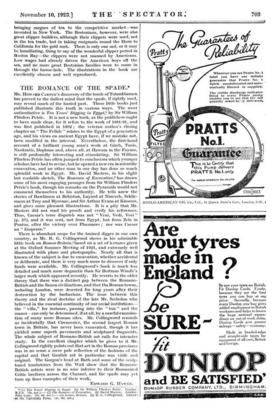THE ROMANCE OF THE SPADE.*
MR. HOWA En CARTER'S discovery of the tomb of Tutankhamen has proved to the dullest mind that the spade, if rightly used, may reveal much of the buried past. These little books just published illustrate this truth in various ways. The most authoritative is Ten Years' Digging in Egypt,1 by Sir William Flinders Petrie. It is not a new book, as the publishers ought to have made clear, for it refers to the work of 1881-91, and was first published in 1892; the veteran author's closing chapter on " The Fellah " relates to the Egypt of a generation ago, and his views on ancient Egypt have, if we mistake not, been modified in the interval. Nevertheless, the first-hand account of a brilliant young man's work at Gizeh, Tanis, Naukratis, Daphnae and, above all, at Hawara in the Fayurn, is still profoundly interesting and stimulating. Sir William Flinders Petrie has often jumped to conclusions which younger scholars have had to revise, but he opened a new era in scientific excavation, and no other man in our day has done so much splendid work in Egypt. Mr. David Masters, in his slight but readable sketch, The Romance of Excavalion,2 has drawn some of his most engaging passages from Sir William Flinders Petrie's book, though his remarks on the Pyramids would not commend themselves to his authority. He tells anew the stories of Rawlinson at Behistun, Layard at Nineveh, Schlie- mann at Troy and Mycenae, and Sir Arthur Evans at Knossos, and gives some pleasant illustrations. It is a pity that Mr. Masters did not read his proofs and verify his references. Thus, Caesar's terse dispatch was not " Veni, Vedi, Veci " (p. 57), and it was sent, not from Egypt, but from Zcla in PontuS, after the victory Over Pharnaces ; nor was Caesar an"Emperor."
There is abundant scope for the trained digger in our own country, as Mr. R. G. Collingwood shows in his admirable little book on RomanBritain,3based on a set of lectures given at the Oxford Summer Meeting of 1921, and extremely well illustrated with plans and photographs. Nearly all that is known of the subject is due to excavation, whether accidental or deliberate, and there is very much more to discover if only funds were available. Mr. Collingwood's book is much less detailed and much more dogmatic than Sir Bertram Windle's larger work which appeared recently. He reverts to the older theory that there was a distinct gap between the Romano- British and the Saxon civilizations, and that the Roman towns, including London, were deserted for long years after their destruction by the barbarians. The issue between this theory and the rival doctrine of the late Mr. Seebohm who believed in the essential continuity of our social institutions— the "villa," for instance, passing into the " tun " and the manor—can only be determined, if at all, by a careful examina- tion of many more Roman sites. Mr. Collingwood reminds us incidentally that Cirencester, the second largest Roman town in Britain, has never been excavated, though it has yielded some superb pavements and sculptured fragments. The whole subject of Romano-British art calls for intensive study. In the excellent chapter which he gives to it Mr. Collingwood rightly points out that art in the Roman provinces was in no sense a mere pale reflection of the fashions of the capital and that Gaulish art in particular was virile and original. The Gorgon's head at Bath and some of the sculp- tured tombstones from the .Wall show that the Romano- British artists were in no wise inferior to their Romanized Celtic brethren across the Channel, and the spade may yet turn up finer examples of their work.
EDWARD G. HAwRE.
• (1)Ten Years' Digging in Egypt. By Sir William Flinders Petri,.. Londsn : R.T.S. 13s. net.)—(2) The Romance of Excavation. By David Masters. London: John Lane. (Os. 8d. net.1—(3) Roman Britain. By B. 0. Collingwood, Oxford : vat the University Press, 12s. ed. net.]














































 Previous page
Previous page